Review GSM smartphone Nokia 7710
Standard kit:
- Nokia 7710
- Charger
- Table rest
- CD with a program for synchronization
- USB cable for synchronization
- Extra stylus
- Case
- A cloth for the screen
- 128 MB MMC card
- Manual
Nokia 7710. Live pictures

Nokia has been carrying out experiments in smartphone functionality and design and here it can surely be called a pioneer. Platform 60-based devices became mass and this is the main direction of the company's development being proved permanently. At the same time several branches appeared representing in particular a series of 80 platform-based communicators. The main differences are great dimensions, the presence of a keypad and a large screen. Such phones as Nokia
9300, Nokia
9500 belong to this class. The devices are mainly intended for the professionals, they are well positioned, have no direct rivals and Nokia is the only manufacturer developing this direction.
In the end of 2002 the company representatives tried to make a forecast of various market segments development and appearing users' demands. The research resulted in the appearance of a class of game devices, which are smartphones, mainly intended for games but not business functions. In their turn the company tried to diversify the existing solutions and direct them to various price segments and users' groups. Thus an idea of a game console N-Gage interesting as an experimental model demonstrating a game device concept but completely unsuccessful as a device of a new kind appeared. I'll remind Nokia invested much money into the promotion of the device and distinguished it from the line. Though many errors were made while producing the game console. The user was scared away by the impossibility to speak on the phone in a usual manner since the device was to lean with its side surface. Few games, their high price and poor security services (free access for other 60-platform based devices) made the smartphone unsuccessful. Nokia had been refusing the failure of the project and claimed a great number of items has been sold. But under the pressure of distributors and press they had to admit the device was out of success.
At the same time with N-Gage development the company decided to create a new class of Media Devices with the main task to provide the most functionally saturated solution on the market. The development started at the same time with a communicator line and these devices distinguished mainly in the screen technology (touchscreen support) and an OS version Symbian 7.0s. The 60-series came equipped with a younger version of the OS. The main goal of the Nokia 7700 developers was to realize screen input. The company considered the task trivial and thus claimed Nokia 7700 would appear in summer 2004. In fact the problems the developers ran across were serious, the device was unstable and impossible to release. The deadline was shifted slightly on the first stage and the device was supposed to appear in the 2Q 2004. In the end the company realized the device was morally outdated and would loose to the growing number of MS Windows devices and many 60-platform smartphones.
My first meeting with Nokia 7700 fell on October 2003, when the device looked as a prototype and behaved correspondingly, any attempts of using screen input caused the smartphone's failure. In December the next example behaved more stable though the problems remained unsolved. For some time I lost my interest to the smartphone and accidentally got it only in the autumn 2004. It started working correctly, but even its working speed decreased, the interface reacted on pressures with a certain log, delay. That's curious the reaction of the hardware button was quite correct.
At that time the company announced from the end of the year the device would be available only for the partners and would remain a test product. The general public will have no chance to buy Nokia 7700. In some time the company announced a bit retouched version of the device - the 7710. The differences are minimal concerning the design, the camera change for the megapixel one, internal memory increase and some software improvements. The company needed to show its possibilities of manufacturing such a product and try to compensate its expenditures on developing that were really high. At the same time with the representation of the model the manufacturer tells about the end of 90-platform development and thus Nokia 7710 is the last representative.
Nokia's CEO Jorma Ollila mentions that a touchscreen and gesturing will now appear in the 60-platform devices and a separate development line in the 90-platform is being removed. The most curious is only one day separates these two announcements of the company (the announcement of Nokia 7710 and the end of the 90 platform). Even more curious is to hear the product managers' words about Nokia 7710's potential and high sales for its segment. And the question why the company refused a similar class of devices at all leads to no sensible answers.
The reason might be the 60-platform became the most successful in the company's line, the most number of rivals licensed it and software is wide spread and various. The development of a separate line would demand great investments and would result in producing direct rivals to the N-Gage. And thus the platform development should have been stopped with minimal loss. The ideal variant is to realize some Nokia 7710 devices that will partly cover the expanses. Nokia 7710 will not be supported globally since a dead-end branch may account only on a regional focus and an attempt of drawing attention due to some marketing or PR-actions.
Design, battery life, ergonomics
In the manual Nokia 7710 is called an intelliphone that stands for an intelligent phone. The idea of some opposition to smartphones is traced. The gradation between the mind and intellect is clearly seen. The name is mainly artificial and is unlikely to settle down on the market widely.

The dimensions of 128x69.5x19 mm are the maximum for today and exceed even some devices based on MS Windows Mobile, I-Mate Jam, for instance. Compared with today phones the model looks a giant but looking at smartphones you understand the device is not too thick, just comparable to usual ones. The size plays a double role; on the one hand it's impossible to operate with one hand and at that take its weight of 189 grams into account. On the other hand the device is uncomfortable to wear, it won't fit a shirt pocket and look like a digital camera on the neck, even the feelings are comparable. The thing we recommend is to carry the phone either in large pockets of sports jackets or in a bag. I feel hard to call a device of such dimensions mobile.

Here and further comparisons with Sony Ericsson products will appear in the review. That is not because they are direct rivals of Nokia 7710 (there are no any) but is caused with the fact the company was the first to launch smartphones with touchscreens run by Symbian. For the moment Sony Ericsson has been selling a 3G device and Nokia launches the first commercial device at the same time (and it is the last now).


The dimensions of Sony Ericsson P910 are 115x57x24 mm and the weight is 155 grams with a flip and 140 without it. Comparing the numbers we may consider the difference not crucial, but Nokia 7710 looks a bit bigger in reality, it crosses the threshold for mobile phones and is larger than many PDAs.
The screen having the resolution of 640x320 pixels and taking the major place of the front panel of the device caused the dimensions. It is 65K TFT. The quality is high, the colours are bright and the picture is seen well especially that concerns preinstalled applications and interface. As for own photos taken with the camera the quality leaves much to desire. But that mainly concerns the camera and not the screen. Due to its size the screen flashes in the sun and fades greatly. In general the size plays a positive role and information can be read. The horizontal orientation of the screen is comparable to communicators by the company, it is ideal for working with text documents, e-tables and viewing web-pages.
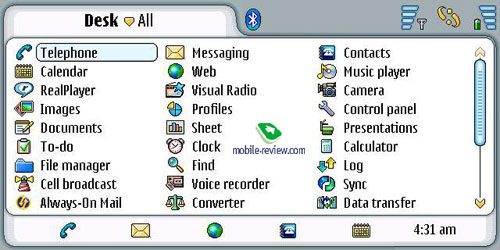
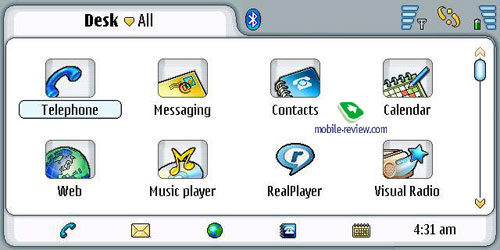
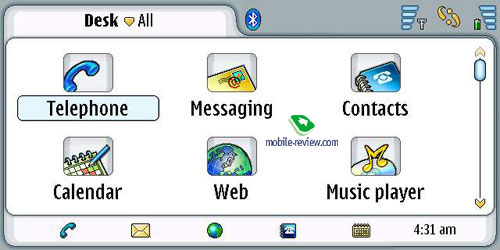
There is a zoom function for font-size, icons in the smartphone. An upper button on the right side is responsible for it. The screen is the most comfortable to read from with an average font-size. Extreme values are not as pleasant, but applicable in some situations.
The screen is sensory and that means working with a stylus integrated into the side of the device. The stylus is not bad, weighty and pleasant to touch. The only thing that may be done without a stylus is dialing a number, a virtual keypad is large. But anyway you'll have to engage both hands otherwise the device will fall. Using a stylus is necessary in all the other working modes. A navi button with an OK integrated is on the left-side surface and a context menu button is a bit lower; it also calls applications from the memory, the main menu. An ESC button is on the opposite side.
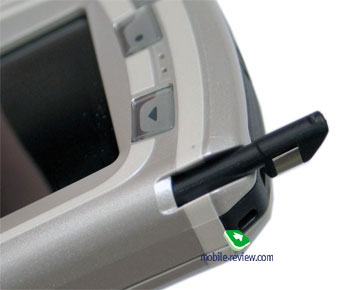
The device is ideal to work with both hands; the fingers lay comfortably on control buttons. The device is comparable with game consoles in some way and it might have been created looking back on them.

A leather case in included into the phone kit. It serves for protection and can't be used as a holster since has no corresponding holes. There is a small perforation against a loudspeaker in a closed mode and theoretically that allows speaking without opening the case. In fact that's uncomfortable and the sound quality is low. The volume of the call signal is low when using a case, that is a minus. The presence of holes for all the control button and connectors is an advantage thus they are always available. There is a pocket with a black velvet ribbon (microfibra) on the internal side of a case, it may be used to wiping fingerprints from the screen. The weight of the device is surely more than 200 grams with the case.
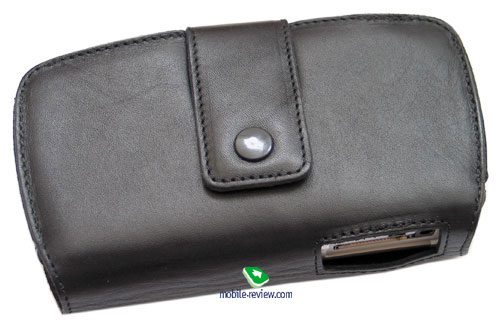
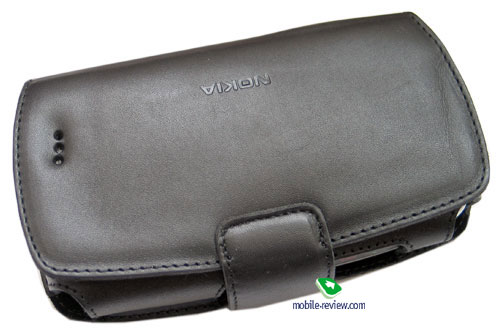
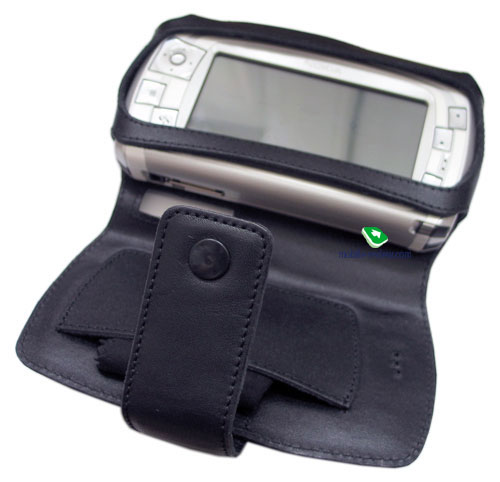
Marks stay on the screen after speaking since it is lean to the body with the main part of its surface. Speaking on the phone is quite comfortable if not taking into account the fact the hand gets tired when speaking for long, thus you'd better use a headset.
The presence of a dictaphone button on the side surface is a strength of the device. So, you can start recording or voice dialing with one press. The same button activates speakerphone function during a conversation. Start and End call buttons are also there.

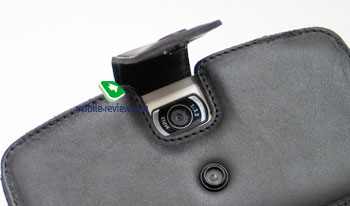
A megapixel camera objective can be seen on the backside. A loudspeaker gap is only one. You can open the device by pushing the catch and pulling the panel up. The panel is placed well and has no backlash. You can see a MMC connector inside and it is accessible without removing the battery. The manufacturer means hot card change for the smartphone but you should remember about the back panel dismantling before. That is no very comfortable and easy in the majority of cases.
A SIM-card is inserted into a connector, the fixing is reliable. Plugging the card out is possible using the stylus. The battery is 1300 mAh (BP-5L) Li-Pol. According to the manufacturer the device may work for 12 hours in the talk mode and up to 14 days in the standby mode. The data is more than impressing but in reality it is not true. In Moscow the device worked for about a day in case of one hour of talks and up to an hour of using other functions (neither mp3 player nor a radio). If decreasing the backlighting to 50 percent or less working time will increase for 10-15 percent. If the actions are well-taken is for you to judge, the screen is the best thing of the phone. The maximum working time formed about 2 days in case of 40-45 minutes of talks, about an hour of working with the device and about 1.5 hours of listening to music (mp3 or radio). Full recharging takes about 2.5 hours.

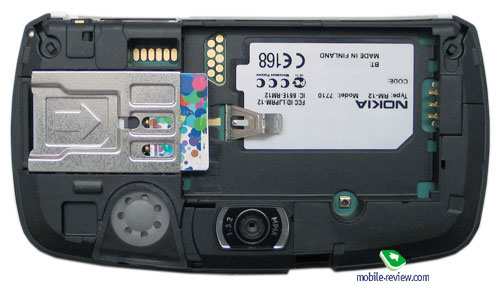
A rest for 7710 is included into the kit. It is rather ascetic and resembles things from IKEA. Two plates are fixed across and thus you get a holder where the 7710 may be plugged into. It will be useful on the table if you want to see video on the smartphone.
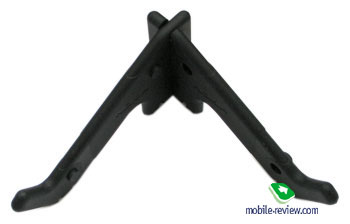

Processor, memory, performance
Unfortunately, we failed to find data about the processor operating frequency. Reasoning from the fact the model is similar to Nokia 9500 in hardware we can take it as 150 MHz. The smartphone comes equipped with 90 MB of dynamically shared memory. That is enough for all your needs and considering the device has an MMC connector, problems with memory are unlikely to appear.
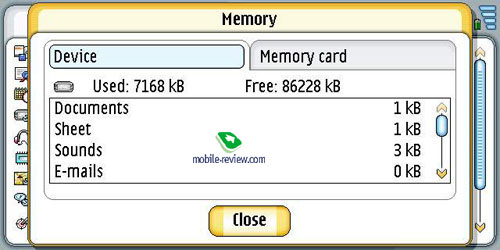
The performance of the smartphone is its real weakness. In particular, when working with the menu, you can notice some delay between pressing of this or that item and its calling. Many operations concerning selecting and copying many files take much time. These all allows telling the smartphone is slow and operating speed is unlikely to be increased since it is limited with hardware.
We also failed to launch 3D Jbenchmark since the program permanently closed. Some other Java applications behaved the same way, and opening speed was mainly too slow. The second version of Jbenchmark showed Nokia 7710 is a real outsider in productivity. The best result was 58 points with the 2.08 software version, and our 3.04 version showed a worse result of 51 point. Just to compare - Nokia 6630's result is 246 and Motorola A780's 59 points. Nokia 7700 had a practically similar result of 48 points. The test also showed the device has rather acceptable possibilities for working with texts, but is really weak in interface and graphics (both 2D and 3D). The smartphone looses not only to other manufacturers but also to Nokia phones.
Text input
The presence of a touchscreen means using a virtual keypad for entering text. The realization of virtual keypad input is well-taken in Nokia 7710, there is a possibility to switch between various layouts and several languages are supported at the same time. Letters may be entered only using the stylus; you won't manage to type them with your finger.
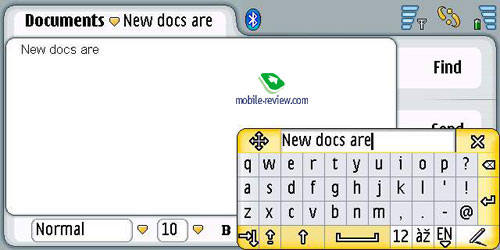
The second way to enter text is hand recognition working for all the supported languages including Russian. The realization is simple - letters may be written in a pop-up window. The speed of the device reaction is acceptable though writing with a virtual keypad is faster. The window may be of two sizes. It may be moved along the screen. For instance, in Sony Ericsson smartphones you can write in any corner of the screen, the input is fast though localization gives way to Nokia 7710.
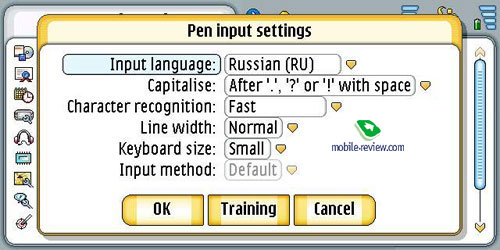
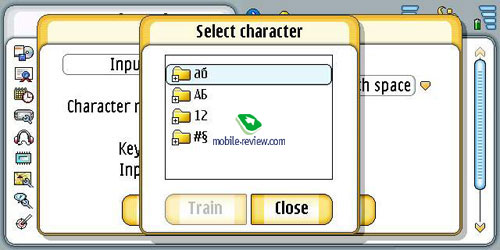
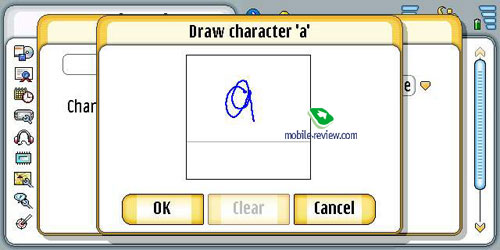
Camera, video
The same module as in Nokia
7610/Nokia 6670 is installed in the smartphone, though another software is used (the differences are slight though tell upon the picture quality). Photos taken with the 7710 are not very good. The CMOS matrix provides relatively acceptable results in the daylight. Comparing picture quality with Nokia 6630 we can see it loosing to Nokia7710. The photo is saved for 3-4 seconds in the internal memory and up to 10 seconds on a memory card. Brightness, contrast, three types of photo quality, 2x zoom are supported. In general the camera settings are ascetic and it is one of the weakest in its class.
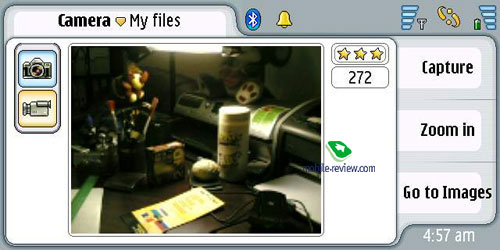
Photo sample,
the maximum resolution, in the street, JPEG, 302 KB
Photo sample,
the maximum resolution, in the street, JPEG, 360 KB
Photo sample,
the maximum resolution, in the street, JPEG, 341 KB
Photo sample,
the maximum resolution, in the street, JPEG, 488 KB
Photo sample,
the maximum resolution, in the street, JPEG, 402 KB
Photo sample,
the maximum resolution, in the street, JPEG, 297 KB
Photo sample,
the maximum resolution, in the street, JPEG, 301 KB
Photo sample,
the maximum resolution, in the street, JPEG, 508 KB
Photo sample,
the maximum resolution, indoors, JPEG, 298 KB
Video with average quality may be recorded for about an hour.
Video sample, 3GP,
203 KB
Standard applications
The smartphone provides applications known by other devices, for example, Nokia 9300. There are differences neither in realization nor in ideology. Just remember a possibility of screen input, an image editor appeared (you may draw on the screen). The interface is realized typically with separate sections for programs and various functions. Standard menu lines offer such operations as selecting, copying, insertion and others. The device is more convenient to work with a stylus
.
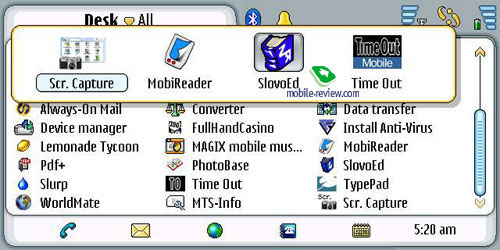
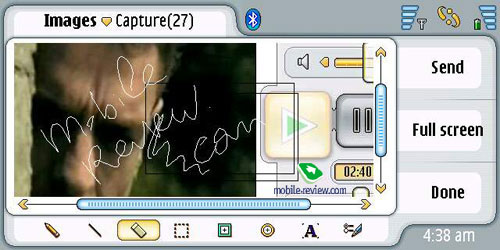
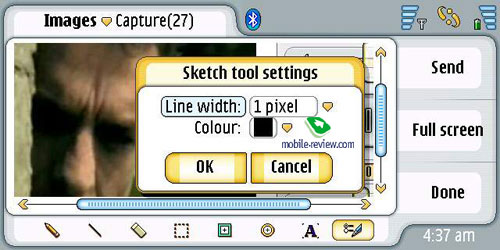
Contacts. The number of the name is not limited and practically any set of numbers may be entered for a name (extra fields are available from the editing menu). There is an own picture for fields; synchronization with MS Outlook rouses no problems. We won't describe all the capabilities; they are maximum just as it should be in a communicator.
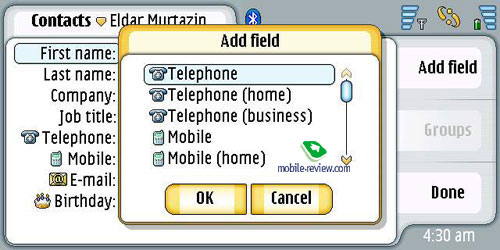
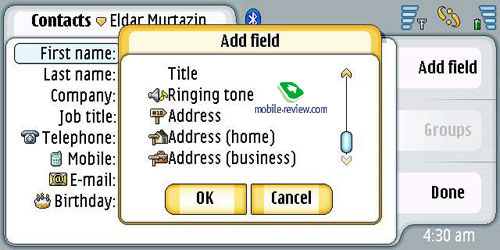
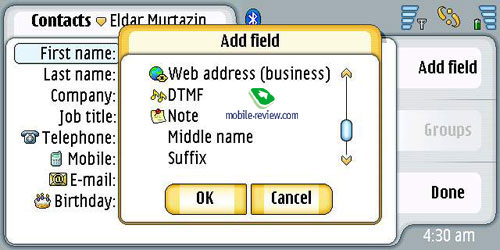
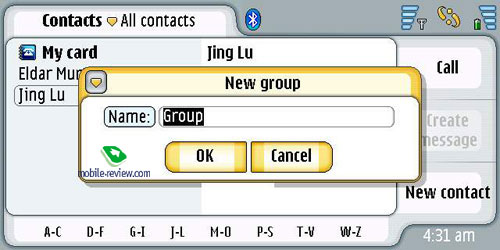
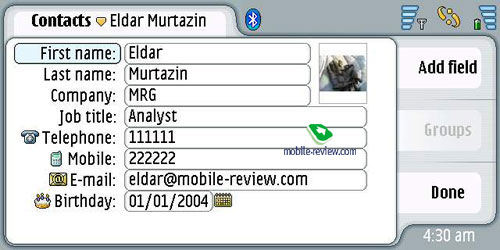
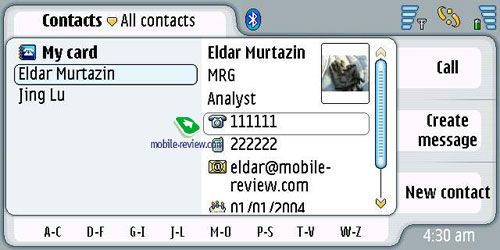
Alarm clock. The alarm clock may be set once or recurrent for special days of the week. You may turn several alarm clocks at the same time.
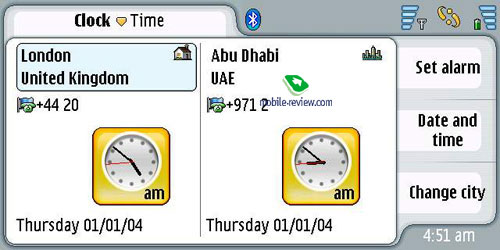
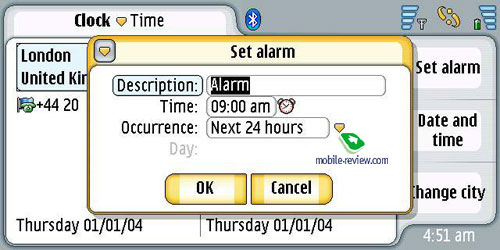
Calendar. All the possible fields and reminders are supported, calendar view - monthly, weekly and daily. An event may have a period, personal alarm signal, a text note and the period time is set if necessary. Distinguishing the status of the events with color is an advantage.
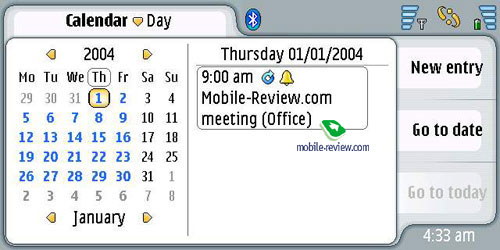
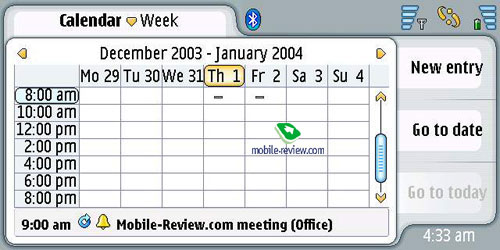
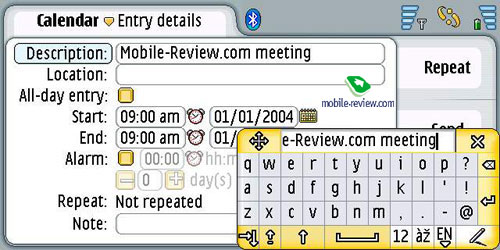
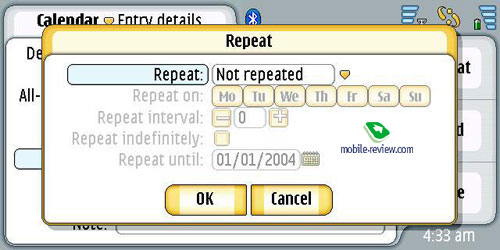
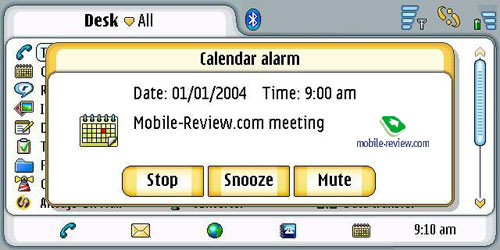
Call lists. Three standard lists have no restrictions on the number of entries; you may view bookmarks for every call type (incoming, outgoing and missed) and apply filters to the lists.
File manager. A plain application that allows managing all the files in the internal memory and MMC-card one.
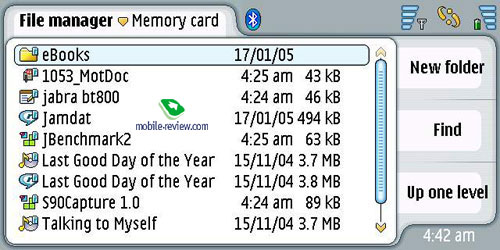
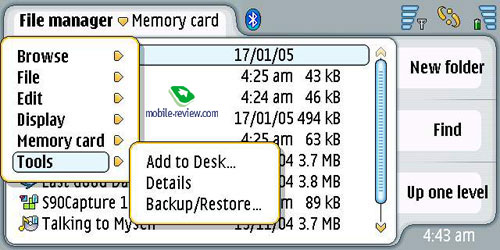
Documents, Sheet, Presentations. You may create files compatible with MS Word, Excel and apply any format texts without any third party programs. Presentations menu as it is clear from the name you may create own presentation or view the ones loaded from a PC. There are restrictions put on the file size and integrated into the presentations objects. At first sight the program seems to be good for a pocket device.
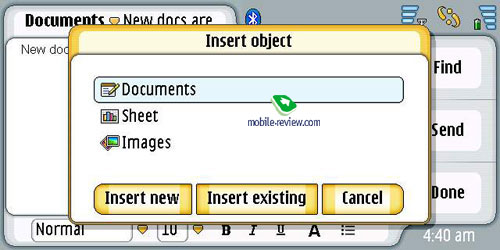
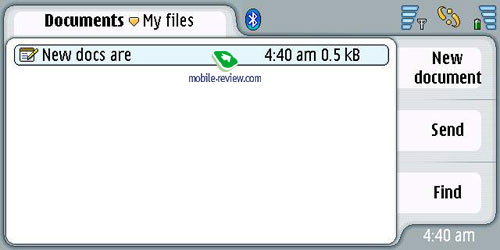
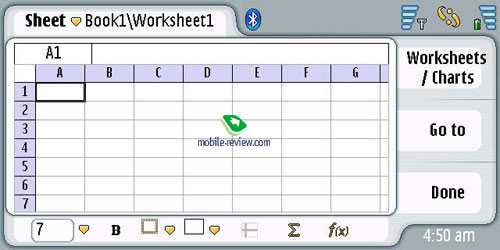
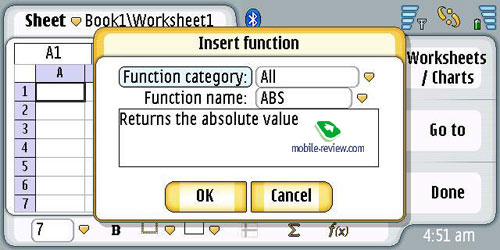
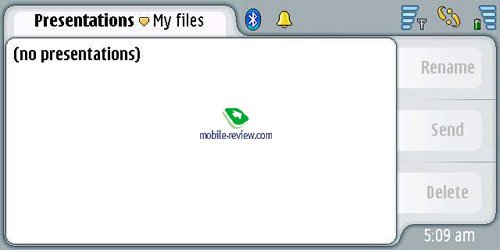
Calculator. A usual or engineering calculator may be used and everything is rather simple.
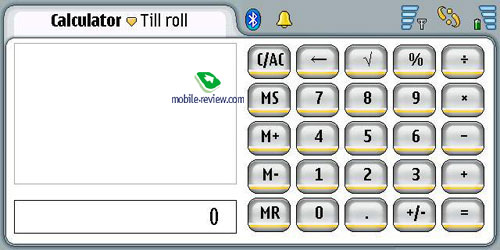
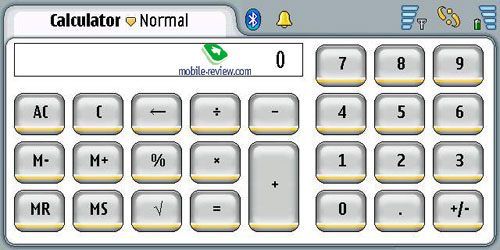
Currency converter.
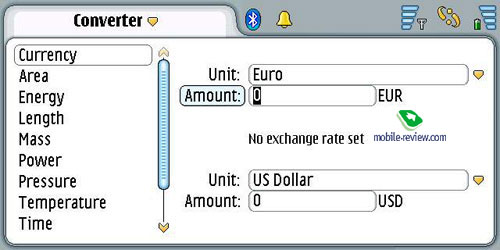
Messages. The device supports SMS, concatenated messages and Nokia Smart Messaging. Everything is plain and clear. The same organization is in usual phones by the company and working with a text is more comfortable here due to the presence of the keypad.
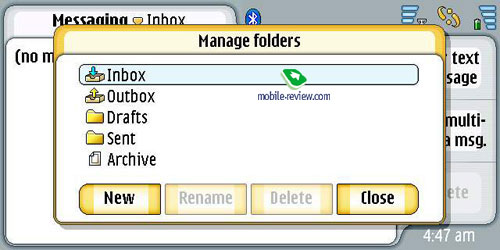
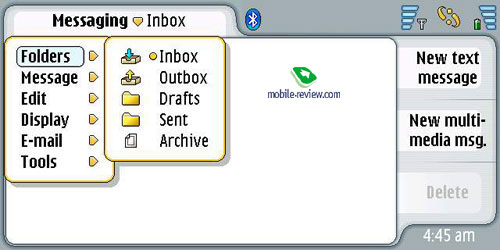
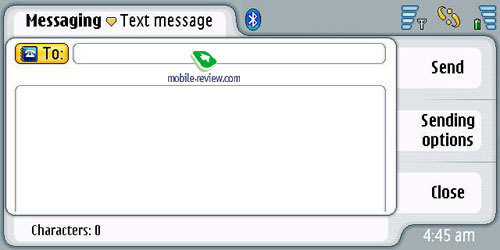
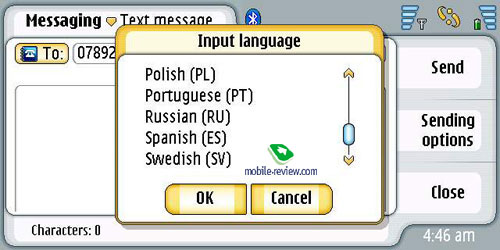
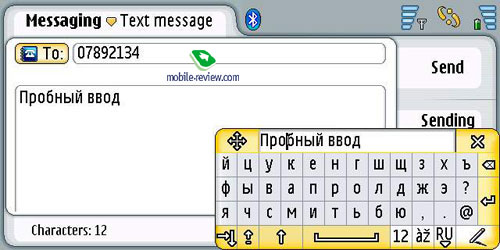
MMS are easy to create and send, no any peculiarities.
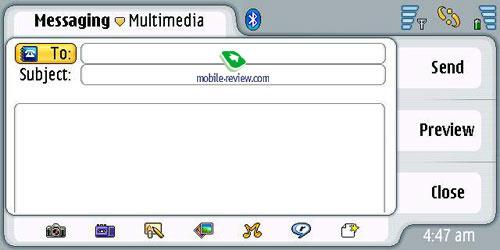
E-mail. Several text codings are supported; there is no an automatic mail delivery on time but authorization for SMTP appeared.
Voice recorder allows saving amr or wav files.
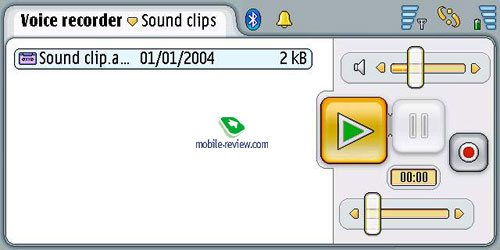
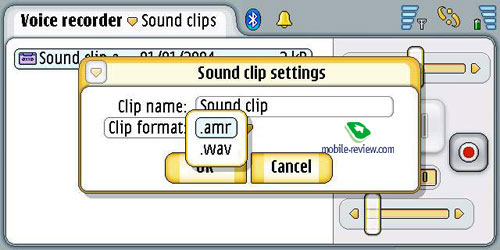
Music Player. Allows reproducing the majority of standards and a standard output provides stereo sound. A disadvantage is that it's possible to work only with one selected folder (and an advantage is that a list of last viewed folders is available from the menu). Nokia 7710 may be used as an mp3 player but it's not reasonable.
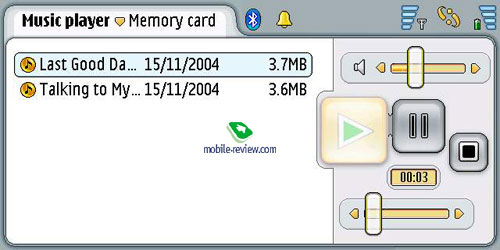
Visual Radio. A usual FM-radio enhanced its possibilities due to the extra service appearance. You can get all the data on reproduced melodies, composers and so on. The service is may be used if having good data connection.
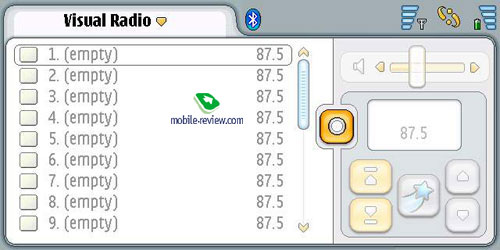
Real Player. This player used for viewing the majority of multimedia formats has nothing special to say about.
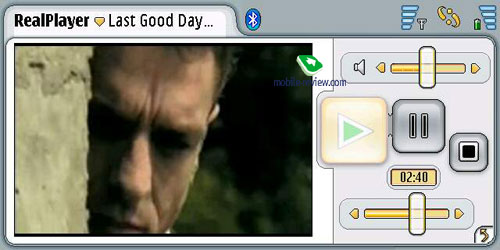
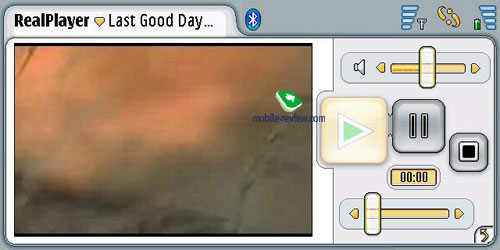
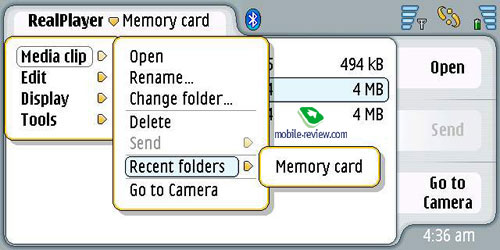
Opera. This browser has recommended itself well and has no rivals in mobile phones for today, this is a de-facto standard. It scales the page for the screen size automatically. Russian codings are shown incorrectly sometimes.
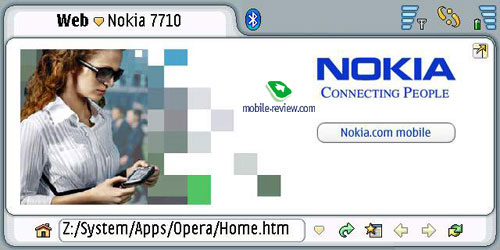
Pdf+ views pdf files.

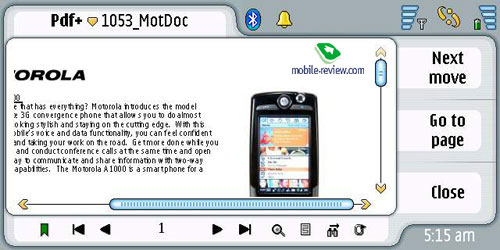
MobiReader is a program for reading electronic books.
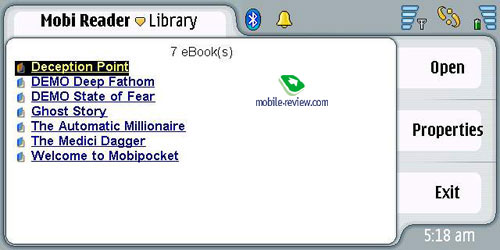
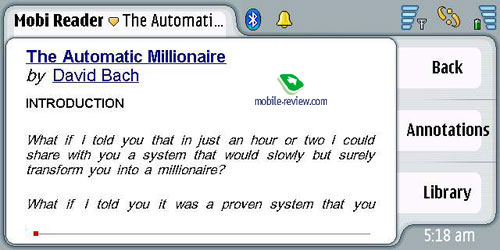
Screen Capture. The program allows making screen shots.
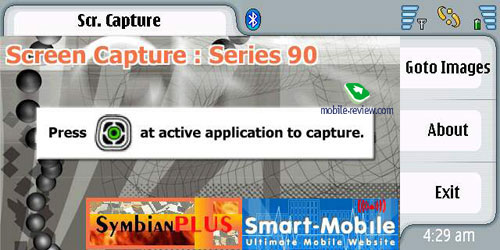
Lemonade tycoon is a well-known game where you act as a lemonade seller.
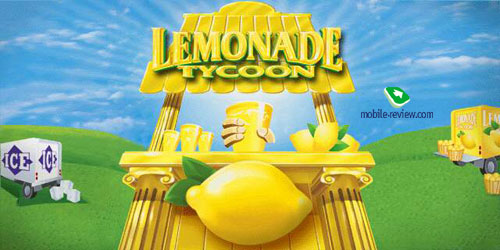
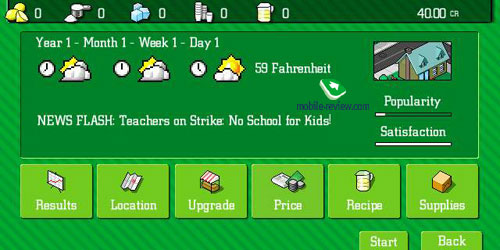
Connection possibilities. There is Bluetooth support (all the possible profiles, but we haven't checked any exotic ones). Any file may be transmitted on and from the phone. The device supports EDGE but that's not actual for today. In the second half of 2005 the technology may get popular in many countries.
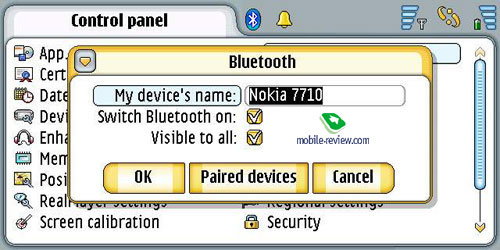
Synchronization with PC was carried out using PC Suite and no synchronization with MS Outlook Notes, Email is provided, everything is standard. Synchronization via bluetooth or a standard USB-cable.
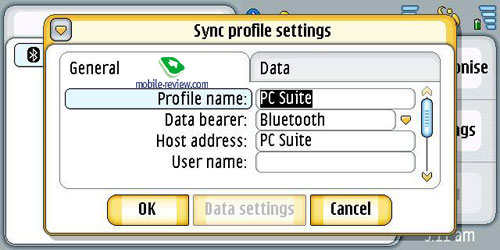
Impressions
The call signal volume is enough when the device lies on the table or in an overcoat pocket, hearing it from a bag is possible not always. Any file may serve as a signal. Rather a weak vibra is present as different to communicators. There is no any logical explanation of the presence of vibra, and the majority of users will carry the device not in a pocket but in a bag.
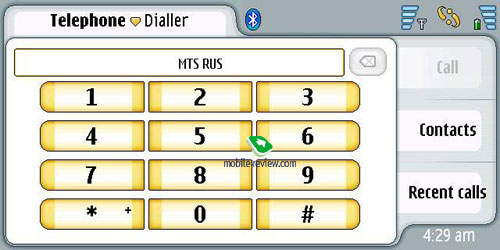
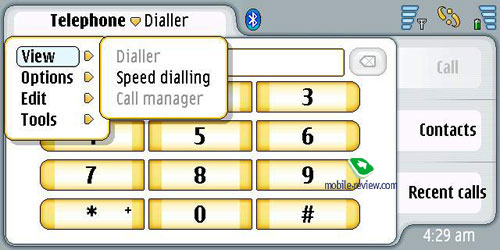
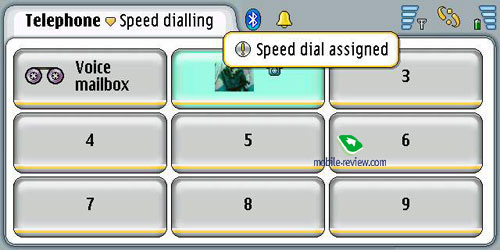
The device is rather hard to use as a usual phone due to its size. It is even larger than a PDA equipped with a VGA-screen. The ergonomics is rather dubious and using the phone everyday is just uncomfortable. You'll have to use both hands and don't forget about a bag you'll carry the device in.
This discomfort is smoothed away when using a bluetooth headset permanently. Musical possibilities of the phone are standard and represented by radio and mp3 player. Carrying this thing for these two functions seems too cruel to yourself. The same Sony Ericsson S700 is not very little that is what users complain of, but this device is huge compared to it.
The screen is the main advantage of the device and in fact there is nothing interesting more. Slow work of the device makes it unpleasant to deal with the phone. The tests show Nokia 7710 is an obvious outsider among other devices. The disadvantages may be described for long and there are no evident advantages. Unfortunately, Nokia 7710 was some kind of a dead product from the beginning, and the company admits it also since the product is the last based on 90-platform. That is practically impossible to get programs for the device and not many of them are likely to appear. There are no rivals for the model not because nobody can make the same but nobody sees any reason in manufacturing such a product. There is no market for the model; it competes with all the phones and none at the same time. Two years ago Sony Ericsson cancelled developing a similar game device since they saw no market for it.
The conclusion is rather simple - buying it is possible if you have much money and are ready for brave experiments. Anyway you can try what Nokia 7710 is in a shop. Words about mythic "power", "strength", and "functionality" of the device do not pass real life tests; the smartphone is uncomfortable in everyday life. If you need a business device, you'd better have a look at Nokia 9300/Nokia 9500. They have a higher operating speed and comparable functionality. If you need a touchscreen, you'd better turn to Sony Ericsson products or MS Windows Mobile smartphones.
Eldar Murtazin (eldar@mobile-review.com)
Translated by Maria Mitina (maria.mitina@mobile-review.com)
Published — 7 March 2005
Have something to add?! Write us... eldar@mobile-review.com
|












































































